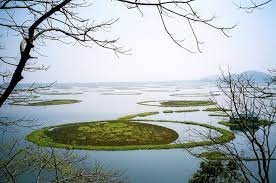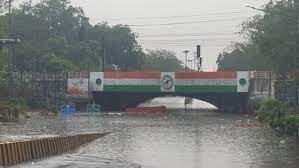- Six Reasons To Bring Millets To The Market!
- Hong Kong Court Makes Landmark Ruling Protecting Transgender Rights
- Substrate Promiscuity Of Fungi Generated Enzyme Laccase Shows Potential In Degrading Industrial Dye Effluents
- Union Minister Of Rural Development Holds A Meeting On ‘Cactus Plantation And Its Economic Usage’
- Ministry Of Tribal Affairs Organised One Day Mega Health Camp ‘Abua Bugin Hodmo-Our Better Health’ At Saraikela Kharsawan, Jharkhand
- Blue Flag Standards For Beaches In The Country
- India-Namibia Sign An MoU On Wildlife Conservation And Sustainable Biodiversity Utilization
- Hydrophobic Ingredients, In Combination With Obsolete Antibiotics, Can Counter Multidrug-Resistant Bacteria
- Promoting Cultivation Of Kala Namak Paddy
India adds 10 more Ramsar sites
Posted by: 2022-08-06 18:13:03 ,By Admin

India has added 10 more names to the Ramsar list — that designates wetlands of international importance — taking the total number of such sites in the country to 64, a statement by the Union environment ministry said on Wednesday.
According to the statement, the 10 new sites include 6 wetlands from Tamil Nadu and one each from Goa, Karnataka, Madhya Pradesh and Odisha.
“Absolutely thrilled to inform that 10 more Indian wetlands have got Ramsar recognition as wetlands of international importance. This takes India’s tally of Ramsar sites to 64. Special congratulations to Odisha, Goa, Tamil Nadu, Karnataka and Madhya Pradesh,” tweeted Union environment minister Bhupender Yadav on Wednesday.
Under the convention on wetlands, an intergovernmental treaty, contracting parties are expected to identify and place suitable sites on the ‘List of Wetlands of International Importance’, also known as the Ramsar List.
So far, 64 wetlands covering an area of 1,250,361 hectares have been designated as Ramsar Sites of International Importance from India. The 10 sites designated recently include the Koonthankulam Bird Sanctuary which is a man-made wetland in Tirunelveli district of Tamil Nadu. It is the largest reserve for breeding resident and migratory water birds in South India and an ‘Important Bird and Biodiversity Area’ forming part of the Central Asian Flyway, a brief by the ministry of environment, forest and climate change (MoEFCC) states. The wetland also irrigates about 190 acres of paddy.
Nanda Lake in Goa, another addition to the list, has freshwater marshes that lie adjacent to one of the major rivulets of the Zuari river, said the brief. This enables local residents to store water during the off-monsoon season. The stored water is also utilised to cultivate paddy downstream of the lake and supports fishing and recreation, it said.
According to the brief, the lake is a habitat for Black-headed ibis, Common kingfisher, Wire-tailed swallow, Bronze-winged jacana, Brahminy kite, among others.
Satkosia gorge, which is also on the list, is spread along the Mahanadi in Odisha. Established in 1976 as a wildlife sanctuary, Satkosia is the meeting point of two biogeographic regions of India; the Deccan Peninsula and the Eastern Ghats, contributing immense biodiversity, according to ministry’s brief.
Satkosia gorge wetland is a mosaic of marshes and evergreen forests. The forests of these catchments play a vital role in the prevention of the gorge siltation. They also help in maintaining a desirable depth of water crucial for the endangered gharial population, the brief added.
Among the seven other sites on the list, Gulf of Mannar Biosphere Reserve (GoMBR) is one of the most important located on the southeastern coastline. The Reserve is home to several globally important and highly threatened species like the Dugong, Whale Shark, Seahorses, Balanoglossus, Green sea turtle, Hawksbill Turtle, Dolphins, Sacred chanks etc.
“The ten new sites are some of India’s most picturesque sites. Many of them are also Important Bird Areas, significant for the migratory birds on the Central Asian Flyway, getting more than 20,000 birds each year. This is a good opportunity for the state to decide what kind of expansion we want to have in our Ramsar sites. There is a proposed pharmaceutical expansion inside Vedanthangal bird sanctuary, which is India’s oldest bird sanctuary. There is a proposal to expand pharma production inside the wetland, which is chemical-intensive and does not help the wetland as a habitat. We need to rethink. With so many new Ramsar sites, India should draw up a fresh approach for wetlands. Sites with global importance should support artisanal livelihoods and activities which sustain the ecosystem, not hinder it,” said Neha Sinha, wildlife biologist and author
The Convention has several mechanisms to guide parties designate their most significant wetlands as Ramsar Sites, and to take the steps necessary to manage them effectively by maintaining their ecological character. “Ramsar Sites are designated because they meet the Criteria for identifying Wetlands of International Importance. The first criterion refers to Sites containing representative, rare or unique wetland types, and the other eight cover Sites of international importance for conserving biological diversity. These criteria emphasize the importance the Convention places on sustaining biodiversity,” the Ramsar convention website states.
Last week, India had added 5 wetlands to the list — Karikili Bird Sanctuary, Pallikaranai Marsh Reserve Forest and Pichavaram Mangrove in Tamil Nadu; Pala wetland in Mizoram and Sakhya Sagar in Madhya Pradesh.
Read more: Click Here
You may like similar news

View: Delhi's rain chaos is a reflection of poor political-bureaucrat leadership
It is also a reflection of political leadership which has not been able to make the bureaucracy acco...
.jpg)
Sikkim landslides: 9 killed, over 1,200 tourists rescued; schools shut | Top updates
Sikkim landslides: 9 killed, over 1,200 tourists rescued; schools shut | Top updates Since June 13,...
.jpg)
Delhi records its warmest night of 2024 at 35.2°C, highest minimum in 13 years
Delhi records its warmest night of 2024 at 35.2°C, highest minimum in 13 years The IMD has fore...
Delhi Weather and AQI Today: Warm start at 32.05 °C, check weather forecast for June 12, 2024
Check the weather forecast and air quality updates for Delhi on June 12, 2024 here. The temperature...

'False statements, tanker mafia...': Supreme Court slams Delhi government over water crisis
Advocate Shadan Farasat, appearing for the Delhi government, said they had taken action to stop wast...









